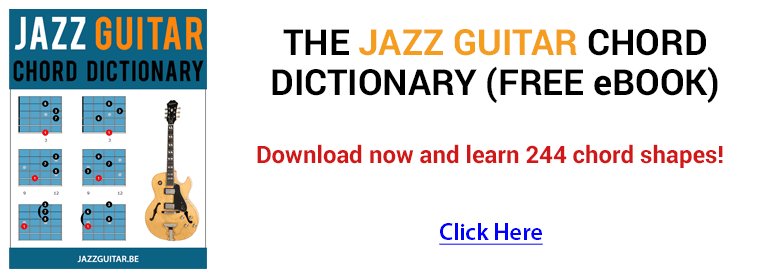-
well done, fritz, I hope we hear much more from you!
 Originally Posted by fritz jones
Originally Posted by fritz jones
wiz
-
12-17-2015 10:15 PM
-
Rob, that fingering is also new to me. Thanks for the fingering.

-
This is an inversion of Db7 (with 7th in the bass). It seems more exotic when you analyze it relative to G, but it's just a tritone substitution. Every 7th chord voicing you know works over both its own root and the root a tritone away.
 Originally Posted by Rob MacKillop
Originally Posted by Rob MacKillop
-
I'm aware of that, but didn't make the connection in this instance. Thanks for reminding me!
-
 Originally Posted by Rob MacKillop
Originally Posted by Rob MacKillop
Rob, thanks - just trying to work this out myself:
in 12 and 13 how about the Db major scale over the Ab13 and the Bb major scale over the F7?
In 19 & 20 do you mean Gm rather than G?
and how about the Db major scale in 33 & 34?
-
 Originally Posted by fritz jones
Originally Posted by fritz jones
Wow, that's really excellent. You're on a wholly different plane than me. I hope at some point you might talk a little about how your feeling/thinking through the tune, if that's okay.
A very nice handling of this tune, it made my day!Last edited by Franklin52; 12-19-2015 at 08:06 AM. Reason: Add missing [ to quote
-
Nice, Jehu. I keep wishing I could see the headstock on that guitar, man, like, what is that you play? Your own private luthier? ;-)
 Originally Posted by Jehu
Originally Posted by Jehu
-
Well, yes - he made that great guitar himself!!
-
 Originally Posted by boatheelmusic
Originally Posted by boatheelmusic
Db Major scale over Ab13 - yes, that works, because effectively you would be playing the mixolydian mode on Ab, the V of Db.
Bb Major scale over F7 - ditto. There are two ways to look at it - either the major scale on the major chord, or the mixolydian mode on the V chord. Same notes.
"In 19 & 20 do you mean Gm rather than G?" - The Am7b5 (half diminished) followed by the D7b9 would normally indicate a ii-V in a minor key, so, yes, one would expect Gm to follow. However, what we find is G augmented - a pleasant surprise - which has a Major 3rd, so can be viewed as GMajor#5. The whole-tone scale would be my scale of choice for the G+.
"and how about the Db major scale in 33 & 34?" - I can see why you would choose Db Major for the C half-dim, but it has a few questionable tones over the F7 chord. For instance, the F chord has an A natural in it, one of the defining notes of the chord (the major 3rd), but the Db Major scale has Ab and Bb. There are no bad notes in jazz (despite our worst efforts, lol!), but there are some that are perhaps "less good". It's another example of the strangeness of this piece, and what attracts me to it: the minor 2-5 chords leading to a Major chord. My rule is: when in doubt, arpeggiate!
I hope that helps? I think it's good to discuss these things, rather than just upload a performance with no comment, although doing so would be better than nothing at all. Just my opinion.
-
Here's my submission - I value your feedback:
-
Here's my first version. Quick and Dirty. I'm planning on doing a slow one too later in the month.
Editing is horrible.
Feedback is welcome as always.
-
Just exploring other areas in terms of harmony, phrasing etc. Still noodling.... A "final" version would have to be pulled back a bit to play it more cleanly, in time more, and with better overall structure (or maybe I can work some of these things out "all the way").
I'd appreciate anyone's feedback. This tune is about at my limits. Need to memorize it and listen to other versions etc. Maybe in January.
Last edited by matt.guitarteacher; 12-19-2015 at 12:54 PM.
-
Well done, Matt. That was much more swingin than my ballad approach, and you include a solo. Excellent. I view everything I do as work in progress, and I guess you will be polishing this one for a long time to come. Keep it up.
-
I need to steal some Rob and Jehu chord voicings for sure.
 Originally Posted by Rob MacKillop
Originally Posted by Rob MacKillop
-
nice playing to everyone who posted.
I wanted to pass along one tiny variation that is kind of hip: at the very end, when it goes
Em7b5/A7/Dm7b5/G7/cm7b5/F7/Bb/Bb,
try instead
Em7b5/A7/Dm7b5/G7/ Dbm11-Gb7/cm7b5-F7/Bb/Bb.
If you really want to milk it, you can do a whole chromatic descending thing there
Fm11-Bb7/Em7b5-A7/Ebm11-Ab7/Dm7b5-G7/Dbm11-Gb7/Cm7b5-F7/Bb/Bb
at reasonable tempi you can outline the changes in your single line playing and it creates tension against the harmony that keeps resolving itself-sort of- until you hit the Bb where it finally resolves. It also works with the melody if you put those 11ths on top.
and if you really want to reharmonize you can try
Fm11/Bb7/Ebm11/Ab7/Dbm11-Gb7/Cm7b5-F7/Bb/Bb
-
Interesting! I'll give that a try later.
-
Well, a favorite tune of mine, so I had to get in this month...trying a few different things out, but as always, trying to leave space. Hope you enjoy, and if there's something you like, let's discuss...heck, if there's something you don't like, let's talk about that too, because that's important !
-
Very articulate, Jeff, in every way.
-
Thank you!
-
great as always, Jeff.
 Originally Posted by mr. beaumont
Originally Posted by mr. beaumont
What's your setup at school there for recording this?
-
Thanks, Matt.
Just my phone and a Roland Microcube, amp set low and placed close to phone.
By the way, like your posts in this thread a lot.
-
Wow. Didn't realize it was just the phone. Pretty amazing what you can get out of a phone these days. That's the reason for my crazy camera angle by the way. Mic up by the headstock for a mellower steel string, right?
 Originally Posted by mr. beaumont
Originally Posted by mr. beaumont
Thanks for the kind words.
-
Jeff, that was superb. I love your playing - very soulful, good subs, beautiful lines. In short: inspirational. Thanks for that.
-
Jeff, in bar 17 of Howie's score (that would be bar 13 without the 4-bar intro) you are playing a Bb in the bass. I've seen a couple of charts with a Bb chord there, yet Howie has an F. The melody is Eb, so I played it as an F7, but I'm not convinced about the chord. Any thoughts on this?
 Originally Posted by mr. beaumont
Originally Posted by mr. beaumont
Also, (1-minute mark) I love your sub for the BbMaj7 (bars 17&18, Howie's score). From what I can make out you are playing a low E, the tritone note, with a BbMaj6/7 above it. Very cool. I'm going to steal that one
But what are you doing right at the beginning for the A7b9? It looks like you have an open A, G on 4, C# on 3, then instead of playing an F on 2, you stretch all the way back to play it on 1 at the first fret. Is there anything on 2? C? So, are you subbing the A7b9 with A7#5#9? Whatever it is, I like it.
And (if you don't mind all these questions!) what are you playing for the G+ chord in bar 21? Looks like a Galt/D. Sounds great. I was using an augmented chord.
-
Dude, no.... I love a good CM, but the other was good stuff. I've got way uglier than that all over the interwebs. :-)
 Originally Posted by nick1994
Originally Posted by nick1994
Me too. I was looking forward to an answer to this as well. Originally Posted by lawson-stone
Originally Posted by lawson-stone
I'd like to know what your approach was on that first take as well.




 Reply With Quote
Reply With Quote







Is the Bud 6 Really That Good?
Today, 02:33 PM in Guitar, Amps & Gizmos